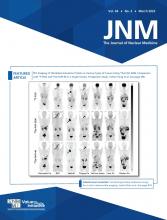An editorial in this issue of The Journal of Nuclear Medicine by the theranostics teams of Dana–Farber Cancer Institute and Brigham and Women’s Hospital addresses ongoing challenges with the rollout of 177Lu-PSMA-617 (177Lu-vipivotide tetraxetan; Pluvicto [Novartis]) (1). The authors highlight several major problems: insufficient and slow supply remains a daunting problem for patients, their families, caregivers, and treating physicians. Most alarmingly, 5% of the authors’ patients died while waiting for treatment, as this can be delayed by 2 mo or even longer (1). These observations match our own experience. The authors point to additional consequences, including long intervals between pretreatment prostate-specific membrane antigen (PSMA) PET/CT scans and therapy rendering patient stratification and treatment monitoring unreliable (1).
The U.S. Food and Drug Administration approved the new-drug application for Pluvicto 9 mo ago. The Centers for Medicare and Medicaid Services has reimbursed for it since October 2022. Novartis halted production of Pluvicto in Ivrea, Italy, and Milburn, New Jersey, in May 2022 and resumed production and delivery at the Ivrea site in June 2022. Yet, Pluvicto availability has remained a significant problem because only one of the two previous sites is currently operational for Pluvicto production.
Drugs are usually considered a failure if they do not meet revenue and profit expectations, which is one suggested reason for the market withdrawal of the CD20 antibody 131I-tositumomab (Bexxar; GlaxoSmithKline) (2). But commercialization starts with successful and compliant drug production and delivery. Patients and their treatment teams lose trust in products that are much talked about but remain largely unavailable. The last-mile requirements for radioligand therapies are specified by Pomykala et al. in this issue (3) and include having a proficient drug supply, meeting infrastructure and regulatory requirements, training competent staff and having them available (including authorized users), establishing reliable reimbursement, and having a sufficient patient referral base. If the first of these requirements remains the key problem, then the rest of the requirements are no longer relevant. Past mistakes in rolling out molecular radiotherapies also included tedious drug-ordering processes, as was the case for another CD20-directed radiotherapeutic antibody, ibritumomab tiuxetan (Zevalin; Acrotech Biopharma) (4).
Novartis recently announced that “Pluvicto demonstrated a statistically significant and clinically meaningful improvement in radiographic progression-free survival…in a randomized trial of patients with PSMA-positive metastatic castration-resistant prostate cancer…after treatment with androgen-receptor pathway inhibitor (ARPI) therapy, compared to a change in ARPI” (PSMAfore, NCT04689828) (5). This, and several ongoing investigator- or industry-initiated late-stage randomized clinical trials, place PSMA-targeted therapies at various stages of prostate cancer, suggesting that indications will broaden and demand will increase dramatically.
Johannes Czernin
What are the solutions? Novartis added a new production site at Purdue Research Park near Indianapolis, and it is hoped that this and the Milburn site will be fully operational later this year. Novartis needs to create further back-up solutions to guarantee a drug supply for new patients whose waiting times are unacceptable and for those who are already undergoing treatment and are waiting for the subsequent therapy cycles. Competition will certainly contribute to solving the supply problem. Several compounds are undergoing testing in phase 3 clinical trials, including SPLASH (NCT0464752, POINT Biopharma/Lantheus) and ECLIPSE (NCT05204927, Curium), and are likely to meet endpoints. These are going to shake up the market in 2024.
Jeremie Calais
As Friedrich von Hayek stated, “A monopoly based on superior efficiency, on the other hand, does comparatively little harm so long as it is assured that it will disappear as soon as anyone else becomes more efficient in providing satisfaction to the consumers.” (6).
- © 2023 by the Society of Nuclear Medicine and Molecular Imaging.









